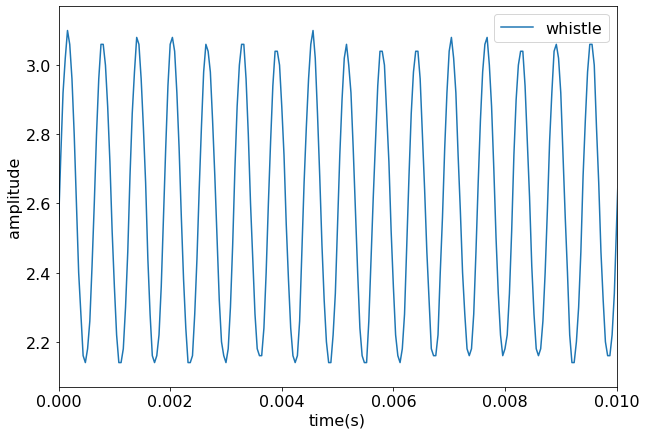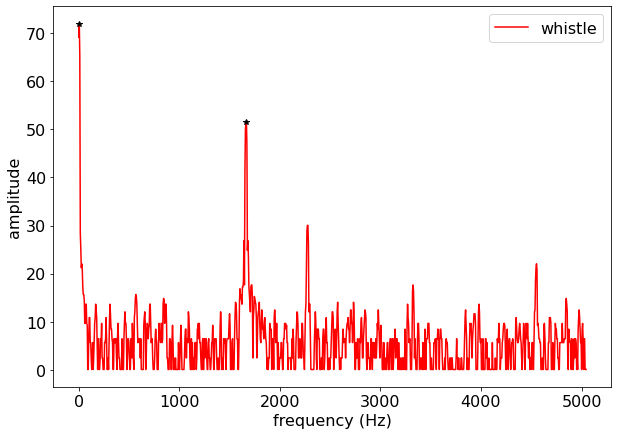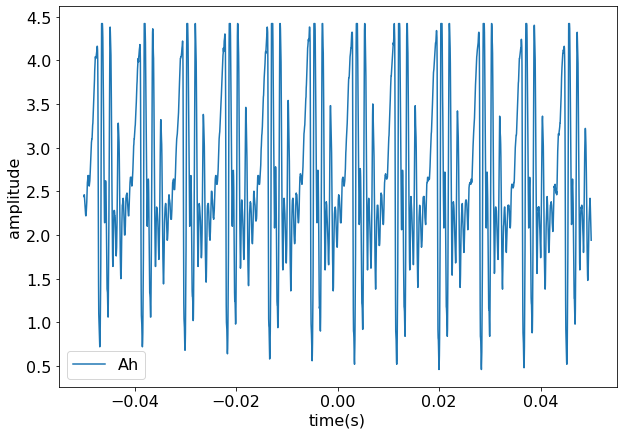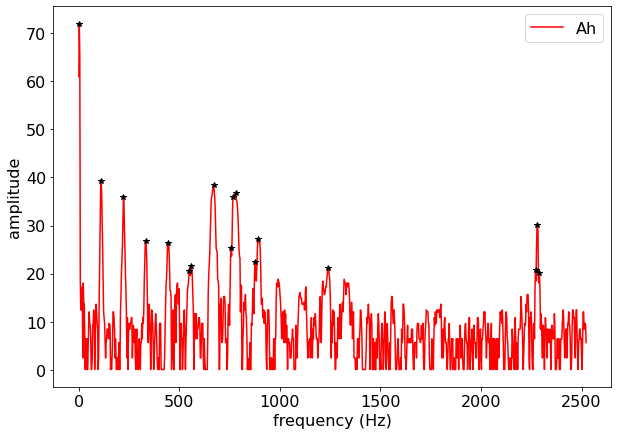import numpy as np
import matplotlib.pyplot as plt
import pandas as pd
from scipy.signal import find_peaks
plt.rcParams["figure.figsize"] = (10, 7)
plt.rcParams.update({'font.size': 16})1Analyzing Sounds¶
Two sounds were recorded. On of whistling into a microphone connected to an oscilloscope. The second sound is of someone saying “ahhh”. The Fast Fourier Transform on the oscilloscope was used to find the frequency spectrum of each sound. The sounds are organized in an Excel file into two columns for time and amplitude and frequency and amplitude. Let’s load it into a Pandas data frame or two.
time_dom = pd.read_excel('./Ah_Whistle.xlsx', sheet_name='time')
freq_dom = pd.read_excel('./Ah_Whistle.xlsx', sheet_name='freq')2Plot the “normal” signal¶
Here is a plot of the whistle, which is a fairly pure tone (single frequency) sine wave.
plt.plot(time_dom['Whistle_t'], time_dom['Whistle_tamp'], label='whistle')
plt.xlabel('time(s)')
plt.ylabel('amplitude')
plt.xlim(0, 0.01)
plt.legend()
plt.show()
2.1FFT¶
The FFT gives the amplitude as a function of frequencies in the signal. Since the whistle is a pure tone, we expect a single spike in the frequency spectrum at the frequency of the whistle. However, there is always a “zero frequency” background in the FFT. We will ignore it. I’m using a peak finding algorithm to get the frequency at the high amplitude frequencies.
peaks, _ = find_peaks(freq_dom['Whistle_amp']+61, height=40)
print(freq_dom['Whistle_f'].iloc[peaks])
plt.plot(freq_dom['Whistle_f'], freq_dom['Whistle_amp']+61, '-r', label='whistle')
plt.plot(freq_dom['Whistle_f'].iloc[peaks], freq_dom['Whistle_amp'].iloc[peaks]+61, '*k')
plt.xlabel('frequency (Hz)')
plt.ylabel('amplitude')
#plt.xlim(0, 0.01)
plt.legend()
plt.show()1 4.93213
338 1667.06001
Name: Whistle_f, dtype: float64

2.2Open up and say “ah”¶
Here is the recording me saying “Ahhh”. it has some regularity (repeating shape), but it is clearly not a single sine wave. In fact it is a sum of sine waves, where the sine waves with the highest amplitudes are the resonances in my esophagus. Let’s see if we can determine the type of resonances (open-open or open-closed ends).
plt.plot(time_dom['Ah_t'], time_dom['Ah_tamp'], label='Ah')
plt.xlabel('time(s)')
plt.ylabel('amplitude')
#plt.xlim(0, 0.01)
plt.legend()
plt.show()
2.2.1FFT and peak find¶
We will do the same peak analysis on the Fourier Transform.
peaks, _ = find_peaks(freq_dom['Ah_amp']+61, height=20)
print(freq_dom['Ah_f'].iloc[peaks])
plt.plot(freq_dom['Ah_f'], freq_dom['Ah_amp']+61, '-r', label='Ah')
plt.plot(freq_dom['Ah_f'].iloc[peaks], freq_dom['Ah_amp'].iloc[peaks]+61, '*k')
plt.xlabel('frequency (Hz)')
plt.ylabel('amplitude')
#plt.xlim(0, 0.01)
plt.legend()
plt.show()1 2.46607
45 110.97310
90 221.94625
135 332.91940
180 443.89255
223 549.93356
227 559.79784
272 670.77099
307 757.08344
311 766.94772
316 779.27807
355 875.45480
362 892.71729
502 1237.96709
921 2271.25042
925 2281.11470
929 2290.97898
Name: Ah_f, dtype: float64

3Conclusion¶
The frequencies are 111, 222, 333, 444, 550/560, 671, 766/779, 893 Hz. These are clearly scaling as
This would imply that the throat is acting like two open ends.